
Face masks are a fun and effective way to pamper your skin. This Seaweed and Cucumber Face Mask is full of skin-loving ingredients and suitable for a variety of skin types. It’s created by emulsifying oils with water, and then adding a mixture of dry ingredients like sea clay and spirulina powder.
The oils in this mask were chosen for their light texture and nourishing properties. Cucumber seed oil is an excellent moisturizer and absorbs quickly. The seaweed extract is dispersed in fractionated coconut oil, which is also light on the skin. They leave the skin feeling hydrated but not oily.
The seaweed extract is part of the new Seascape Collection. It includes a variety of fragrance oils, exfoliants, powders, and more. Click here to explore the entire collection.

The mixture of kaolin clay and sea clay create a thick but spreadable texture that is not overly drying. This mask is good for normal and combination skin. If you have dry skin, you can use less clay as shown in the DIY Lavender Clay Face Mask. If you have oily skin, increase the amount of clay as shown in the DIY Sea Clay Mask.
Spirulina powder is added for color and skin benefits – it’s an algae rich in vitamins, nutrients, and antioxidants. It has a deep green hue, which gives this face mask a beautiful color. If you’ve worked with it before, you know spirulina does have a fishy odor. We found the ginger essential oil in this recipe covered it up nicely.
A few notes about recipe substitutions and changes:
- Polawax Emulsifying Wax is a highly reliable and strong emulsifier. It can be substituted for the generic version, Emulsifying Wax, if you prefer, although this recipe was not tested with it. Due to the clay in the recipe, we splurged and used Polawax Emulsifying Wax to avoid any chance of separation.
- This recipe calls for avocado and cucumber seed oil. Other oils can be used instead if you prefer; we recommend staying with liquid oils that absorb easily into the skin. Changing the total amount of oil in the recipe will change the overall texture of the mask.
- Because this recipe is essentially a lotion and contains a large amount of water, a preservative is necessary to prevent mold and bacterial growth. We chose Optiphen, but other preservatives like Phenonip will work. Learn more about preservatives here.
- Increase the total amount of clay if you want it to be better suited for oily skin, or decrease the amount to make it better for dry skin. Decreasing the amount of clay may create a thinner product.
- If you prefer to use different clays, feel free to swap them. Clays have different absorbing properties, which will affect how the mask feels on the skin. Learn which clay is right for your skin here.
- If you have very sensitive skin, fragrance and essential oils can be irritating. Omit from the recipe if you prefer.
- Seaweed extract can be substituted with a different extract if you prefer. Find more extracts here.

Seaweed & Cucumber Face Mask DIY
What You’ll Need:
Seaweed and Cucumber Face Mask Label Template
Four 8 oz. Bail Jars
21.4 oz. Distilled Water
1 oz. Cucumber Seed Oil
1.3 oz. Avocado Oil
1 oz. Polawax Emulsifying Wax
0.8 oz. BTMS-50 Conditioning Emulsifier
5 oz. Kaolin Clay
2 oz. Sea Clay
0.4 oz. Spirulina Powder
3 mL Ginger Essential Oil
0.5 oz. Seaweed Extract
0.2 oz. Optiphen
Click below to add everything you need for this project to your Bramble Berry shopping cart!
EQUIPMENT PREP: Disinfect your utensils by dipping them in a 5% bleach water solution and allowing to dry. This includes mixing containers, your stick blender, and any spoons or spatulas that may come in contact with your mask. Your products must be as free of germs, bacteria, and microbes as possible. To be safe, bleach water all your utensils.
ONE: In a medium container, measure 5 ounces of kaolin clay, 2 ounces of sea clay, and 0.4 ounces of spirulina powder. Mix them together thoroughly.
 TWO: In a heat-safe container, combine 1.3 ounces of avocado oil, 1 ounce of cucumber seed oil, 0.8 ounces of BTMS-50, and 1 ounce of Polawax. Heat the container in the microwave using 30-60 second bursts until the waxes have fully melted. Be careful when removing the container, as it will be quite hot. Set aside.
TWO: In a heat-safe container, combine 1.3 ounces of avocado oil, 1 ounce of cucumber seed oil, 0.8 ounces of BTMS-50, and 1 ounce of Polawax. Heat the container in the microwave using 30-60 second bursts until the waxes have fully melted. Be careful when removing the container, as it will be quite hot. Set aside.
 TWO: In a separate large container, heat 21.4 ounces of distilled water in the microwave (or on the stove top) until it reaches about 160-170 ° F. Once the water reaches the correct temperature, some of it may evaporate. Remeasure and add more distilled water if necessary until you have 21.4 ounces of hot water.
TWO: In a separate large container, heat 21.4 ounces of distilled water in the microwave (or on the stove top) until it reaches about 160-170 ° F. Once the water reaches the correct temperature, some of it may evaporate. Remeasure and add more distilled water if necessary until you have 21.4 ounces of hot water.
THREE: Check the temperatures of both containers. Each container should be about 160° F. If the oil and wax have cooled, reheat in the microwave. Place the stick blender into the water and burp it to help get rid of bubbles. Pour the oil and wax mixture into the water and use a spatula to make sure every little bit is added. Begin pulsing the stick blender. The mixture will take on a milky appearance once the water, oil, and waxes have begun to emulsify. Continue to pulse and stir for about a minute.
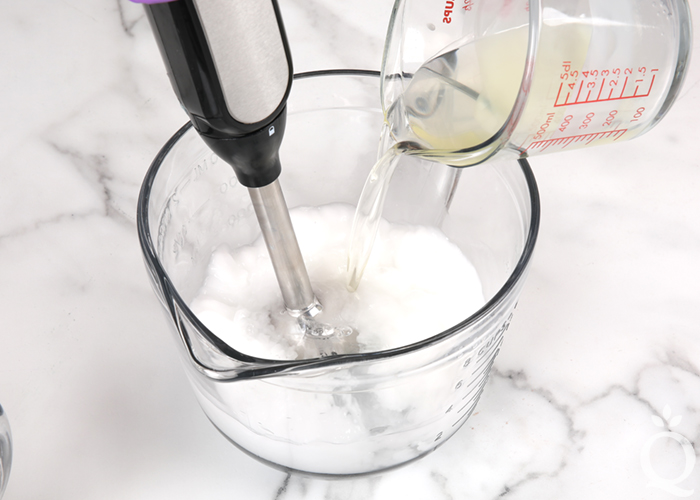
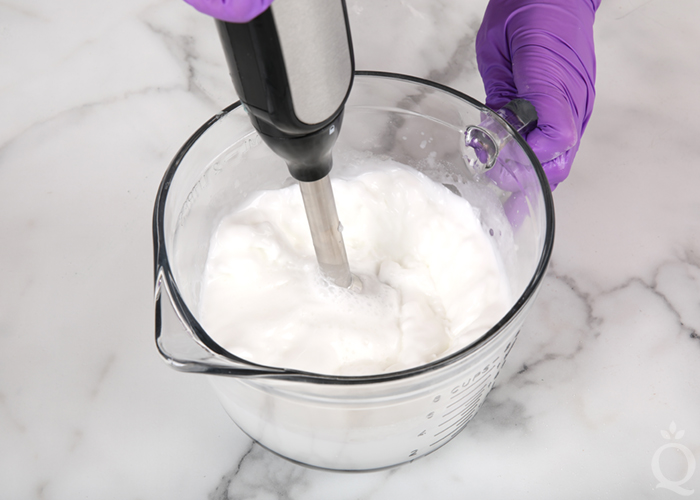 FOUR: Add heaping spoonfuls of the clay mixture and pulse the stick blender until combined.
FOUR: Add heaping spoonfuls of the clay mixture and pulse the stick blender until combined.

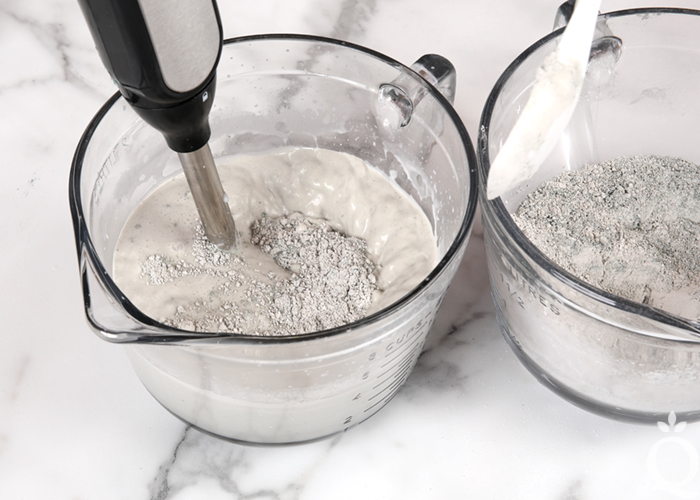 FIVE: Continue stick blending for about 1-2 minutes. Use a spatula to scrape down any clay that may be on the sides of the bowl. Check the temperature of the mixture. Once the mixture is about 130-140°F, add 0.2 ounces of Optiphen, 3 mL of ginger essential oil, and 0.5 ounces of seaweed extract. Stick blend (don’t forget to burp the stick blender) the ingredients until fully mixed.
FIVE: Continue stick blending for about 1-2 minutes. Use a spatula to scrape down any clay that may be on the sides of the bowl. Check the temperature of the mixture. Once the mixture is about 130-140°F, add 0.2 ounces of Optiphen, 3 mL of ginger essential oil, and 0.5 ounces of seaweed extract. Stick blend (don’t forget to burp the stick blender) the ingredients until fully mixed.
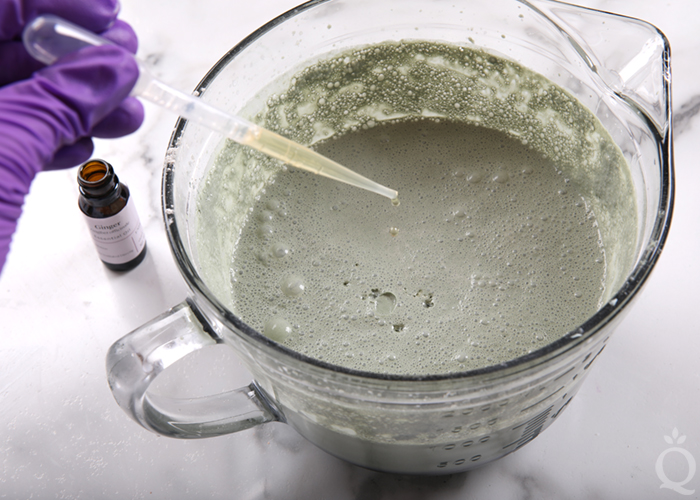 SIX: Pour the mixture into the bail jars. Tap the jars on the counter to help get rid of bubbles. You can also spritz with alcohol to help get rid of bubbles. Allow the containers to cool for several hours with the lid open to prevent condensation.
SIX: Pour the mixture into the bail jars. Tap the jars on the counter to help get rid of bubbles. You can also spritz with alcohol to help get rid of bubbles. Allow the containers to cool for several hours with the lid open to prevent condensation.
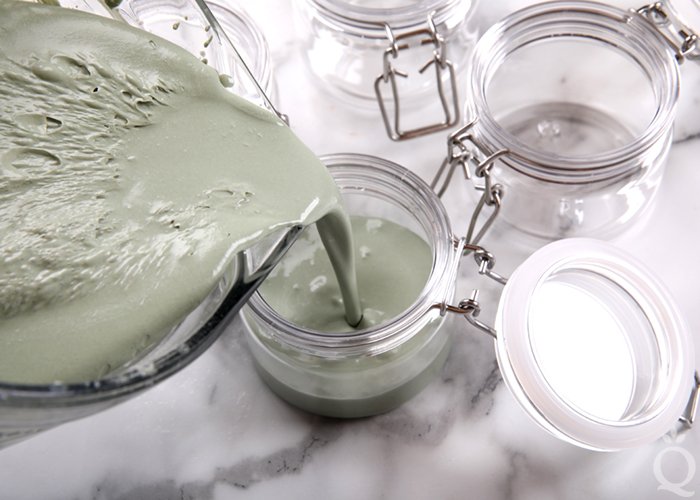

Once fully cooled, the mixture will be a thick, lotion-like texture. To use, apply a medium layer to dry, clean skin. Avoid the immediate eye area. Allow the mask to sit on the skin for at least 15 minutes. Use warm water to rinse off. There is no need to wash the skin after, but you can if you prefer.

- Seaweed and Cucumber Face Mask Label Template
- Four 8 oz. Bail Jars
- 21.4 oz. Distilled Water
- 1 oz. Cucumber Seed Oil
- 1.3 oz. Avocado Oil
- 1 oz. Polawax Emulsifying Wax
- 0.8 oz. BTMS-50 Conditioning Emsulifier
- 5 oz. Kaolin Clay
- 2 oz. Sea Clay
- 0.4 oz. Spirulina Powder
- 3 mL Ginger Essential Oil
- 0.5 oz. Seaweed Extract
- 0.2 oz. Optiphen
- In a medium container, measure 5 ounces of kaolin clay, 2 ounces of sea clay, and 0.4 ounces of spirulina powder. Mix them together thoroughly.
- In a heat-safe container, combine the avocado oil, cucumber seed oil, BTMS-50 and Polawax. Heat the container in the microwave using 30-60 second bursts until the waxes have fully melted. Be careful when removing the container, as it will be quite hot. Set aside.
- In a separate large container, heat the distilled water in the microwave (or on the stove top) until it reaches about 160-170 ° F. Once the water reaches the correct temperature, some of it may evaporate. Remeasure and add more distilled water if necessary until you have 21.4 ounces of hot water.
- Check the temperatures of both containers. Each container should be about 160° F. If the oil and wax has cooled, place back into the microwave until fully melted. Place the stick blender into the water, and burp it to help get rid of bubbles. Pour the oil and wax mixture into the water and use a spatula to make sure every little bit is added. Begin pulsing the stick blender. The mixture will take on a milky appearance once the water, oil and waxes have begun to emulsify. Continue to pulse and stir for about a minute.
- Begin adding heaping spoonfuls of the clay mixture and pulsing the stick blender until combined. Continue to add the clay to the mixture and blend in small amounts until all the clay is added.
- Continue stick blending for about one to two minutes. Use a spatula to scrape down any clay that may be on the sides of the bowl. Check the temperature of the mixture. Once the mixture is about 130-140°F, add 0.2 oz. of Optiphen, 3 mL of ginger essential oil, and 0.5 oz. of seaweed extract. Stick blend (don’t forget to burp the stick blender) the ingredients until fully mixed.
- Pour the mixture into the bail jars. Tap the jars on the counter to help get rid of bubbles. You can also spritz with alcohol to help get rid of bubbles. Allow the containers to cool for several hours with the lid open to prevent condensation.
- Once fully cooled, the mixture will be a thick, lotion-like texture. To use, apply a medium layer to dry, clean skin. Avoid the immediate eye area. Allow the mask to sit on the skin for at least 15 minutes. Use warm water to rinse off. There is no need to wash the skin after, but you can if you prefer.

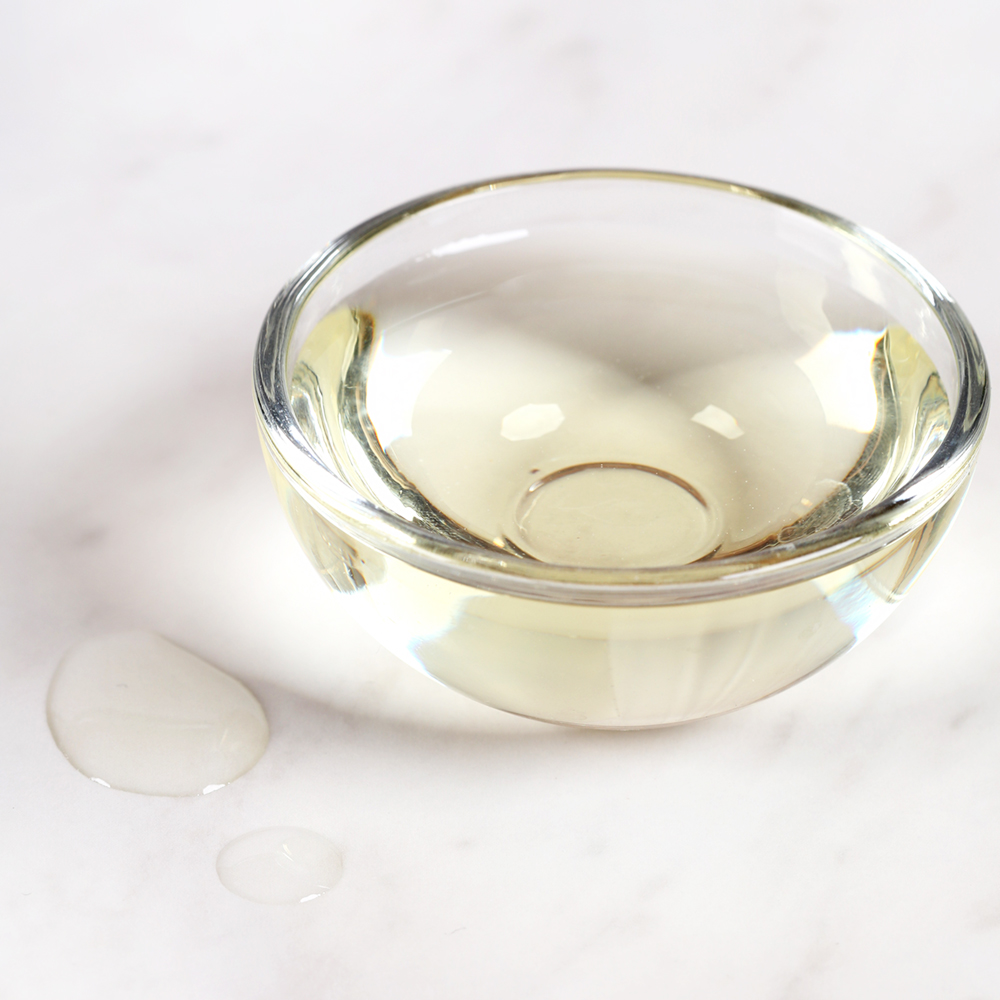
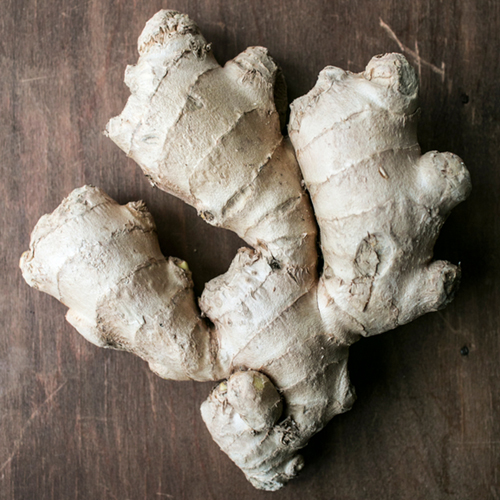














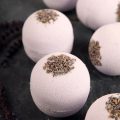
Hi,
Looks like Spirulina Powder is discontinued on your site. What is the substitute for Spirulina Powder ?
Why you dont write the benefits of your masks??
We have written up the benefits of the ingredients in the recipe above. The mask has moisturizing ingredients and spirulina contains some great minerals.
hi! can this be used on the body also?
This face mask would be safe for the body. It is just more common for people to just mask their face. You wouldn’t want to use the mask as a leave on lotion all day due to the clay.
I want to leave out / substitute the seaweed extract. Does it need to replaced by a liquid or can I just omit?
thanks!
Bee
You can just leave out the Seaweed Extract since it is used at such a small amount. You can also replace it with another similar extract, like Buckthorn, or one of the liquid oils from your recipe.
Buckthorn Extract: https://www.brambleberry.com/Buckthorn-Extract-P4930.aspx
I would like to try this recipe, but only making ONE 8 oz of bail jar. How do I adjust the recipes? Is there some sort of calculator I can use? I hope to hear from you.
There is not a calculator for face masks. Though because this recipe makes four jars you can just divide all of the ingredients by four make enough for just one jar.
I would like to make a face mask with bentonite clay,Manuka Honey and apple cider vinegar, matcha green tea, tumeric powder, frankincense oil and lemon oil, but I am unsure about the shelf life of these ingredients and the correct preservative to use.
A mask with those ingredients should have a shelf life of about one year. The Optiphen preservative would still be the best option for that face mask. Though we have not made a mask quite like that so I would recommend making a small test batch first to make sure you like the results.
Hi,
I had a few questions regarding some of your recipes. Is the “Polawax Emulsifying wax” the same as “Pure Cosmetic Grade White Bees Wax?” Also, I was thinking about adding spinach, and green tea powder to this recipe. How much would you recommend I add? Lastly, have you worked with glycerin? Is it in any of your recipes?
I am in the process of becoming an esthetician and want to incorporate all natural products/recipes into my facials, so I am looking to learn as much as I can. Your thoughts and advice will be greatly appreciated.
Thank you in advance,
Beeswax is not considered an emulsifier so you would not be able to substitute the Polawax with it. If you want to add additional powders it will make the recipe drier. If you want it to remain the same consistency you will need to reduce the powders we already have added to it. Glycerin is a humectant and draws moisture to the skin. We have used it in many recipes, though not positive if we have used it in a face mask as it is rather thick.
Can I skip the BTMS 50? If yes then what should I use instead of BTMS50?
You can omit the BTMS-50, but you’ll want to shore up the difference with more emulsifying wax. Your recipe won’t be the exact same silky consistency as ours without BTMS-50, but should hold up just fine.
BTMS-50 can be found here: https://www.brambleberry.com/Btms-50-Conditioning-Emulsifier-P3623.aspx
Can you use a fragrance oil (like the new Sea Salt) instead of essential oil? If yes same ratio – 3ml?
You can use Sea Salt Fragrance Oil, but you will want to use the fragrance calculator to get the right amount. When it asks what you are making, select lotion and enter 36 ounces. Then it will give you three options: light, medium and strong scents.
Here is the fragrance calculator: https://www.brambleberry.com/Pages/Fragrance-Calculator.aspx
How long is the shelf life for something like this?
These masks have a shelf life of 3-6 months. It’s best to store them in a cool, dry place.
Hi! I am adding face masks to my skin care line and am so excited. I would love to do someth but ng like this but add dried sea weed for a fun touch…. is this a bad idea? Just curious what your thought where on this….
Something like this. Crazy auto correct. I guess one thing I thought of was could possible bacteria? Also do these masks need to be refrigerated?
These scrubs do not need to be refrigerated. We don’t recommend adding dried seaweed or any other botanicals to lotions or face masks because of the bacteria that can be introduced. The dried plants often turn brown and mold which ruins the whole batch.
Is the same (or similar) to Ponds cold Creme? OK, I just showed my age! I was just wondering.
It is similar – it’s a mix between a cleansing mask and a lotion. You can also adjust the recipe based on your skin type to make it more cleansing or more moisturizing.